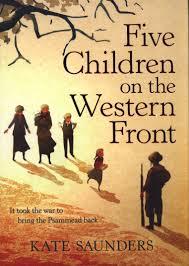
I hope some children today still read E. Nesbit as avidly as I did, and my own children did. I loved everything of hers, but a particular favorite was Five Children and It, the story of a young family -- Cyril, Anthea, Robert, Jane and the baby known as The Lamb -- who find a psammead, or sand fairy, in their garden and get lots of wishes granted, mostly with rather mixed and generally hilarious results. First published in 1902, this novel and its sequels, The Phoenix and the Carpet and The Story of the Amulet, have never been out of print. Kate Saunders obviously loved them too, and was struck by the fact that the two older boys would have been exactly the age to have been called up to fight in the First World War. Hence Five Children on the Western Front.
The novel begins with a prologue, adapted from one of the original novels. The children wish to visit the near future, and are transported from 1905 to 1930, where they find themselves in the room of their old friend the Professor, now a very old man. The two boys admire all the cars they can see out of the window, but the girls look at the photos strewn around the Professor's room. Back home, Anthea is puzzled.
'I saw a couple of pictures of ladies who looked a bit like Mother, and might have been me or Jane. But I didn't see any grown-up men who looked a bit like you boys -- I wonder why not'.
Fast forward nine years to 1914. The four older children are now more or less grown up. Cyril has already joined the army and is off to fight the war, Robert (Bob) is at Cambridge, Anthea at art school, and Jane is finishing school and longing to study medicine. The Lamb is eleven, and a new sister, Edie, aged nine, has appeared since the last novel. The two younger children are used to hearing stories of the Psammead from their older sisters, but they see them as just stories -- until one day the creature itself appears in the sandpit in the garden, every bit as ugly, curmudgeonly and touchy as ever. Once they get over their shock, and have shared the news of their find with their older siblings, the adventures start again.
It's not difficult to guess why there are no photos of the boys in the Professor's room, and I suppose you might expect this to cast a bit of a pall over the story that follows. But in fact, though there are moments of great sadness, the novel manages to end surprisingly well. Certainly some people will never return from the war, others will suffer irrevocable physical damage, and families as a whole will always be conscious of the losses they have suffered. But there is much happiness waiting in the future too -- good careers, happy marriages, splendid children in the next generation. And it's not only the humans who go through powerful learning experiences. The Psammead, too, has a journey to complete, and each wish he grants to the children takes him a further step on the way to self-knowledge and to becoming a better creature.
Kate Saunders has been brave and ambitious to undertake this attempt to combine these much-loved characters with a vision of their future which could have been depressingly dark. But, though the children do indeed visit the Western Front and see Cyril and his mates in the trenches, the emphasis is more on the bravery and cameraderie of the men helping and supporting their fellows than on the horrors of war, although these are not glossed over. So we have realism and fantasy combined, just as they were in Nesbit's original stories. A Christmas present for the children/grandchildren even if they haven't read the originals? Yes, definitely.
